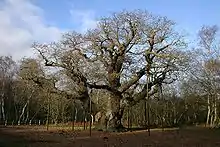Major Oak
The Major Oak is a large English oak (Quercus robur) near the village of Edwinstowe in the midst of Sherwood Forest, Nottinghamshire, England. According to local folklore, it was Robin Hood's shelter where he and his merry men slept. It weighs an estimated 23 tons, has a girth of 33 feet (10 metres), a canopy of 92 feet (28 metres), and is about 800–1000 years old.[1] In a 2002 survey, it was voted "Britain's favourite tree".[2] In 2014, it was voted 'England's Tree of the Year' by a public poll by the Woodland Trust, receiving 18% of the votes.[3] Its name originates from Major Hayman Rooke's description of it in 1790.[4]

Shape

There are several theories as to how it became so huge and oddly shaped. The Major Oak may be several trees that fused together as saplings, or the tree could have been pollarded. (Pollarding is a system of tree management that enabled foresters to grow more than one crop of timber from a single tree, causing the trunk to grow large and thick.) However, there is only limited evidence for this theory as none of the other trees in the surrounding area were pollarded.
History
Since the Victorian era, its massive limbs have been partially supported by an elaborate system of scaffolding.
In 2002, someone illegally attempted to sell acorns claimed to be from the Major Oak on an internet-based auction website.[5]

In 2003, in Dorset a plantation was started of 260 saplings grown from acorns of the Major Oak. The purpose was to provide publicity for an internet-based study of the Major Oak, its history, photographic record, variation in size and leafing of the saplings, comparison of their DNA, and an eventual public amenity.[6]
The Major Oak was featured on the 2005 television programme Seven Natural Wonders as one of the wonders of the Midlands.
The formation sign of the 46th Infantry Division of the British Army in the Second World War was the Major Oak.[7] Among the units of the division were battalions of the Sherwood Foresters regiment.
The threat to the Major Oak from fracking is the subject of a song by English musician Beans on Toast on his 2017 album Cushty.[8]
In July 2020 the tree was reported as vandalised, with a three-foot section of bark fallen off.[9]
References
- Biggs, Paul; Biggs, Sandra (1999). Best Tea Shop Walks in Nottinghamshire. Wilmslow: Sigma Leisure. p. 50. ISBN 978-1-85058-684-5. Retrieved 29 October 2016.
- Nottinghamshire County Council (7 August 2016). "Sherwood Forest Country Park | Nottinghamshire County Council". Nottinghamshire.gov.uk. Retrieved 8 July 2020.
- "'Robin Hood' Major Oak wins Tree of the Year competition - BBC News". Bbc.co.uk. 4 November 2014. Retrieved 29 October 2016.
- Nottinghamshire County Council (7 August 2016). "Sherwood Forest Country Park | Nottinghamshire County Council". Nottinghamshire.gov.uk. Retrieved 8 July 2020.
- "UK | England | Illegal acorns for sale on net". BBC News. 1 October 2002. Retrieved 29 October 2016.
- "Planting a new Oak Wood in Dorset". Eyemead.com. 16 April 2015. Retrieved 29 October 2016.
- "badge, formation, 46th (North Midland and West Riding) Infantry Division (INS 5399)". Iwm.org.uk. Retrieved 29 October 2016.
- "Beans On Toast – Major Oak". Genius.com. Retrieved 31 August 2020.
- https://uk.yahoo.com/news/vandals-damage-tree-sherwood-forest-robin-hood-180519281.html
External links
| Wikimedia Commons has media related to Major Oak. |
